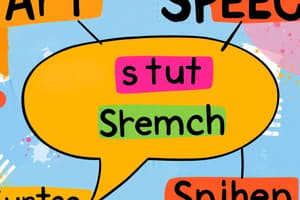Podcast
Questions and Answers
Which type of noun specifically refers to physical objects?
Which type of noun specifically refers to physical objects?
- Abstract Noun
- Proper Noun
- Concrete Noun (correct)
- Common Noun
What is the primary function of a pronoun in a sentence?
What is the primary function of a pronoun in a sentence?
- To replace a noun (correct)
- To express action or a state of being
- To describe or modify a verb
- To show the relationship between words
Which of the following is an example of a linking verb?
Which of the following is an example of a linking verb?
- am (correct)
- run
- write
- think
Identify the type of adverb that describes how an action is performed.
Identify the type of adverb that describes how an action is performed.
Which function do prepositions serve in a sentence?
Which function do prepositions serve in a sentence?
What defines a coordinating conjunction?
What defines a coordinating conjunction?
Which of the following is NOT a type of pronoun?
Which of the following is NOT a type of pronoun?
What is the primary role of an interjection?
What is the primary role of an interjection?
Which adjective type would tell you something about quantity?
Which adjective type would tell you something about quantity?
What distinguishes an auxiliary verb from other verb types?
What distinguishes an auxiliary verb from other verb types?
Flashcards are hidden until you start studying
Study Notes
English Parts of Speech
-
Noun
- Definition: A word that identifies a person, place, thing, or idea.
- Types:
- Common Noun: General names (e.g., dog, city).
- Proper Noun: Specific names (e.g., London, Thomas).
- Abstract Noun: Ideas or concepts (e.g., love, freedom).
- Concrete Noun: Physical objects (e.g., apple, car).
-
Pronoun
- Definition: A word that replaces a noun to avoid repetition.
- Types:
- Personal Pronouns: I, you, he, she, it, we, they.
- Possessive Pronouns: mine, yours, his, hers, ours, theirs.
- Reflexive Pronouns: myself, yourself, themselves.
- Relative Pronouns: who, whom, whose, which, that.
-
Verb
- Definition: A word that expresses action or a state of being.
- Types:
- Action Verbs: Describe physical or mental actions (e.g., run, think).
- Linking Verbs: Connect the subject to a subject complement (e.g., is, are, seem).
- Auxiliary Verbs: Help form tenses or voices (e.g., am, have, will).
-
Adjective
- Definition: A word that describes or modifies a noun or pronoun.
- Examples: beautiful, tall, blue.
- Types:
- Descriptive Adjectives: Describe qualities (e.g., smart, large).
- Quantitative Adjectives: Indicate quantity (e.g., several, few).
- Demonstrative Adjectives: Specify (e.g., this, those).
-
Adverb
- Definition: A word that modifies a verb, an adjective, or another adverb.
- Types:
- Manner Adverbs: Describe how (e.g., quickly, softly).
- Time Adverbs: Indicate when (e.g., now, yesterday).
- Frequency Adverbs: Indicate how often (e.g., always, rarely).
- Degree Adverbs: Describe the extent (e.g., very, too).
-
Preposition
- Definition: A word that shows the relationship between a noun (or pronoun) and other words in a sentence.
- Examples: in, on, at, between, under.
- Usage: Often indicates direction, location, or time.
-
Conjunction
- Definition: A word that connects words, phrases, or clauses.
- Types:
- Coordinating Conjunctions: FANBOYS (for, and, nor, but, or, yet, so).
- Subordinating Conjunctions: Introduce dependent clauses (e.g., because, although).
- Correlative Conjunctions: Work in pairs (e.g., either/or, neither/nor).
-
Interjection
- Definition: A word or phrase that expresses strong emotion or surprise.
- Examples: oh, wow, ouch.
- Usage: Often followed by an exclamation point.
Summary
- Parts of speech classify words by their functions in sentences.
- Understanding these categories aids in proper sentence structure and effective communication.
Noun
- A word that identifies a person, place, thing, or idea.
- Common nouns are general names (e.g., dog, city).
- Proper nouns are specific names (e.g., London, Thomas).
- Abstract nouns refer to ideas or concepts (e.g., love, freedom).
- Concrete nouns refer to physical objects (e.g., apple, car).
Pronoun
- A word that replaces a noun to avoid repetition.
- Personal pronouns: I, you, he, she, it, we, they.
- Possessive pronouns: mine, yours, his, hers, ours, theirs.
- Reflexive pronouns: myself, yourself, themselves.
- Relative pronouns: who, whom, whose, which, that.
Verb
- A word that expresses action or a state of being.
- Action verbs describe physical or mental actions (e.g., run, think).
- Linking verbs connect the subject to a subject complement (e.g., is, are, seem).
- Auxiliary verbs help form tenses or voices (e.g., am, have, will).
Adjective
- A word that describes or modifies a noun or pronoun.
- Descriptive adjectives describe qualities (e.g., smart, large).
- Quantitative adjectives indicate quantity (e.g., several, few).
- Demonstrative adjectives specify (e.g., this, those).
Adverb
- A word that modifies a verb, an adjective, or another adverb.
- Manner adverbs describe how (e.g., quickly, softly).
- Time adverbs indicate when (e.g., now, yesterday).
- Frequency adverbs indicate how often (e.g., always, rarely).
- Degree adverbs describe the extent (e.g., very, too).
Preposition
- A word that shows the relationship between a noun (or pronoun) and other words in a sentence.
- Examples: in, on, at, between, under.
- They often indicate direction, location, or time.
Conjunction
- A word that connects words, phrases, or clauses.
- Coordinating conjunctions are FANBOYS (for, and, nor, but, or, yet, so).
- Subordinating conjunctions introduce dependent clauses (e.g., because, although).
- Correlative conjunctions work in pairs (e.g., either/or, neither/nor).
Interjection
- A word or phrase that expresses strong emotion or surprise.
- They are often followed by an exclamation point.
Summary
- Understanding parts of speech helps with proper sentence structure and effective communication.
Studying That Suits You
Use AI to generate personalized quizzes and flashcards to suit your learning preferences.




